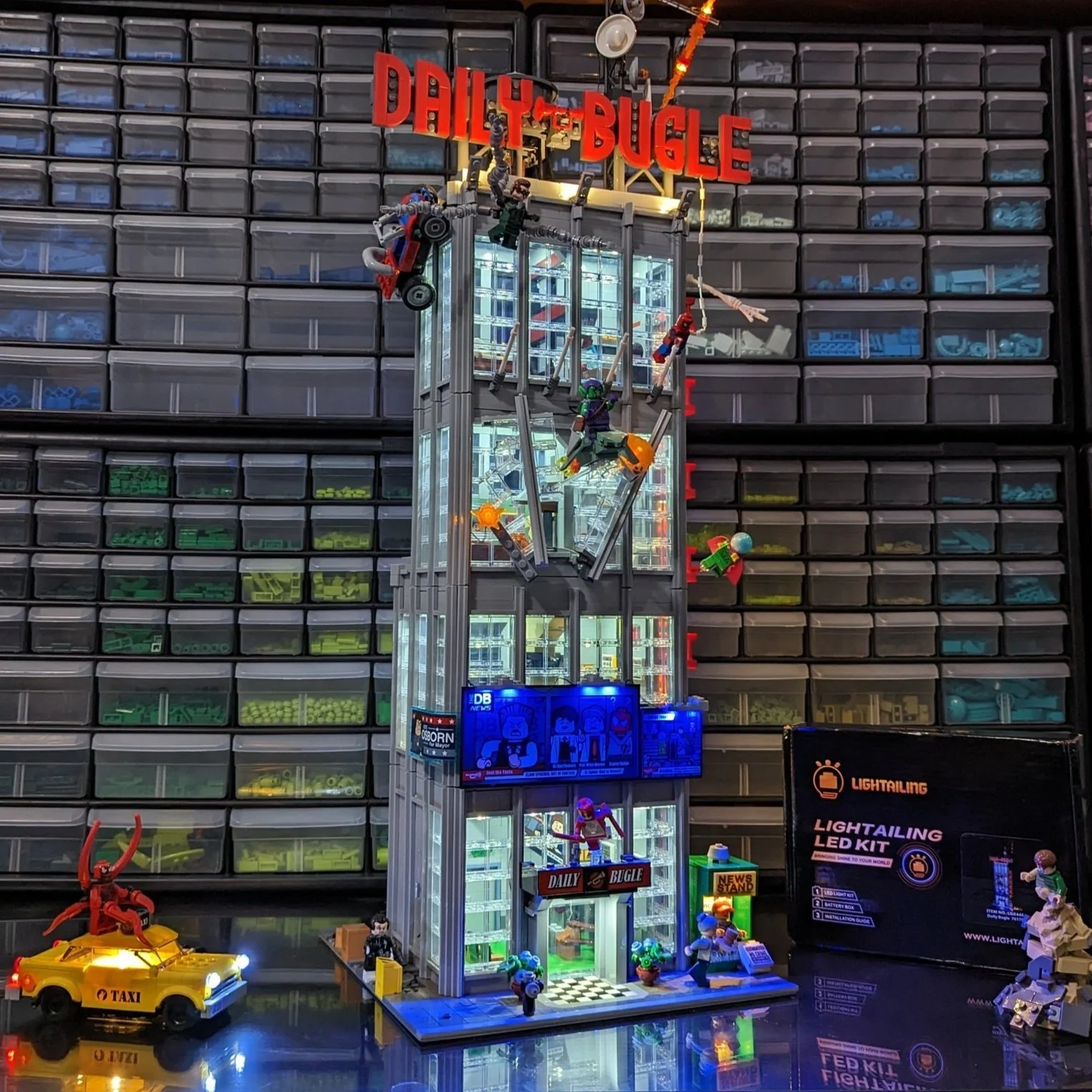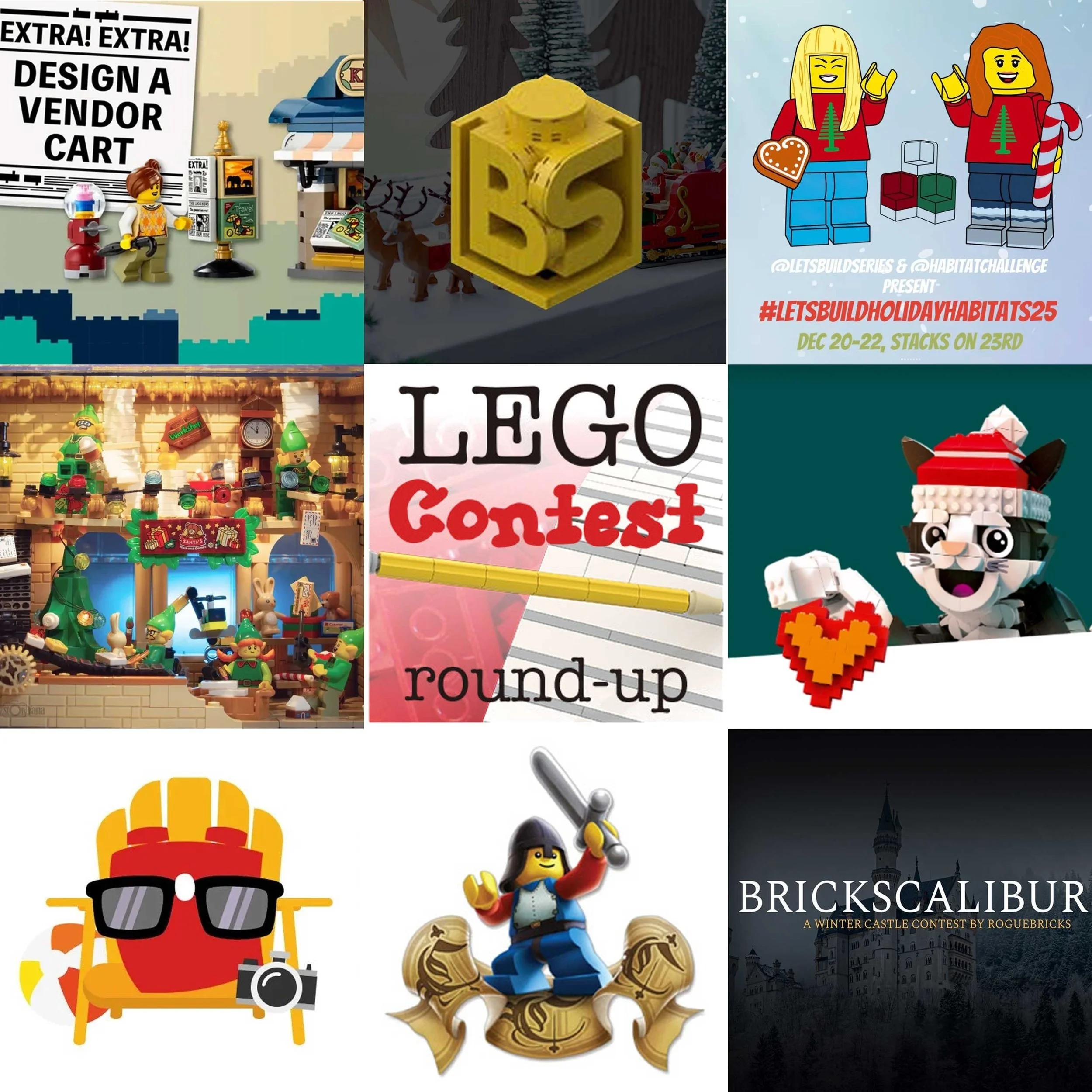Competing to Build a GBC Module From a Single Technic Set
/Today, I am going to take you through my journey of creating a Great Ball Contraption (GBC) module out of a single $33 LEGO Technic set together with my Dutch-speaking GBC friends—and also show what the atmosphere is like at LEGO World Utrecht 2024 when you split up into teams.
For background, BrickNerd-in-Chief Dave challenged me to build a GBC module from a single set and offered to provide the set, too. This way, new builders could have an easy way to enter the world of GBC without having to purchase many different parts. It also would be a fun way to show what the design process is like and give insight into the GBC loop to our readers. With those goals in mind, it was time to choose the set.
Deciding Which Set To Use
While browsing LEGO.com, I searched for a relatively inexpensive set to ensure the module would be as accessible as possible. I set my price range between $25 and $50. Most LEGO Technic sets in this range are various types of cars, which aren’t ideal for GBC modules because they don’t have many gears. After narrowing down the options, I landed on three promising sets:
These sets offered a greater variety of parts and more mechanisms than the cars in this price range. I ultimately chose the Garbage Truck because it featured an interesting mechanism I thought could potentially work well in a GBC module. It also included large panels, which also would prove useful for building the modules.
However, the downside of this set was that it lacks gears larger or smaller than size 12, meaning it would be challenging to gear down the motor to the required GBC standard speed of one ball per second. After some shipping delays from LEGO, BrickNerd was able to provide me with not one but two Garbage Truck sets, the reason being that I might need extra parts or could have both the set and the resulting module built in a single photograph. This ended up being key to this whole story.
LEGO World Utrecht 2024
Initially, I planned to design the module myself but with LEGO World Utrecht—the largest LEGO event in the Netherlands—just a month away, I decided to bring the sets to the event instead. Building together is always more fun… but that gave me an idea. LEGO World Utrecht spans a full seven days (yes, seven!), and there is plenty of downtime during the day and free time in cabins at night.
Poster from this years LEGO world UTRECHT
I had two sets, so what if we split into two teams and created a competition to see who which one could build the best GBC module? When those of us who aren’t repairing machines or picking balls up off the floor, we could work on the module. Even better, all the GBC builders stay in the same cabin, so we would have the perfect environment for some friendly competition. The GBC Set Cup competition was born!
Meet our contestants!
The LEGO World Utrecht 2024 GBC team consisted of seven experienced builders and Leny (Ben’s wife who is always very helpful with running the loop), representing three different nationalities (Dutch, Belgian and Norwegian). Many of the team members are well-known within the GBC community. After randomly splitting into groups, we had our two teams.
GBC Set Cup Team One
From left to right: Maico Arts, Kris Bollen, Berthil van Beek
Team One was a powerhouse of talent, bringing together some of the most skilled builders in the GBC community. Kris Bollen (BE) is celebrated for his practical and innovative modules, consistently taking on building challenges with enthusiasm and creativity.
Joining him was Maico Arts (NL), a true veteran with over 16 years of experience. Maico is widely regarded as the European GOAT in the GBC world, and he is known for his exceptional skills in designing modules and managing large, complex layouts.
Completing this impressive team is Berthil van Beek (NL), renowned for crafting some of the best mechanical art pieces in the GBC world. Berthil is known for his clean designs and has some great mechanical insight into creating modules. Together, they formed a very strong group in terms of experience and knowledge.
GBC Set Cup Team Two
From left to right: Petter Breedveld, Ben Jonkman, Noah de Lange, Philip Verbeek
Team Two was packed with young talent, balanced by its most experienced member—and the oldest participant in the entire layout—Ben Jonkman (NL). Ben brought a wealth of experience in running layouts and designing modules.
Another strong addition to the team is Philip Verbeek (NL), better known online as PV-Productions. His entire GBC lineup consists of modules built from sets, making him a perfect fit for this challenge.
Adding an international flair to the team was Petter Breedveld (NO), known online as Rokreder, who traveled all the way from Norway to attend LEGO World Utrecht. Though not widely known in the GBC community, Petter has a distinct style and unique approach to designing modules. Thankfully, communication between our team members would not have to be in Norwegian because Petter speaks fluent Dutch!
Finally, I, Noah de Lange (NL), was also part of Team Two. I would describe my style as focused on polished GBC modules where I pay just as much attention to the module’s appearance as to its mechanical function.
Determining the Rules
Although this was a friendly competition and just for fun, you always have to follow a few rules when making GBC modules. The final module needed to be fully compliant with GBC standards and functional by the end of the event, when it would be judged by Leny and Patrick Koningh. Their evaluation focused on making use of as many parts from the set as possible—the fewer spare parts left, the better.
Summary of the GBC Standard designed by me and Fredrik Hareide
We also decided that to compensate for the limited number of gears in the Garbage Truck set, builders were allowed to use 15 extra parts, including a motor and not counting the BC balls. However, this addition could influence the competition’s outcome. Lastly, the module had to be compatible with both Power Functions and Powered Up. With the rules agreed upon, the competition was on!
Team One Stepping Up
Maico thinking what he would do with the set on day one
Where do you start when making a GBC module? The core lifting mechanism is something you have to figure out while using minimal parts, so you have enough structure to guide the balls properly through the module. Also, the mechanism should be able to run at the right speedm which is super difficult if you don’t want to use any extra parts.
When I handed the set to both teams, Team One immediately sprang into action. Curious about their approach, I asked Kris about his design process. He explained:
“The design was inspired by an existing stepping module from Maico. We needed a module that could operate at full motor speed, as we had no gears to reduce the speed. Determining whether it was feasible with the available parts was a process of trial and error. We began by constructing the mechanism and then assessed which parts were left to build an input hopper that met the GBC standard. After that, we added a return track, anticipating it would impress the jury. Finally, we used the remaining parts to refine the module's appearance.”
“Reaching the final design required multiple iterations. There wasn’t a predefined process. I simply started building with Maico stepping in to provide feedback and adjustments.”
Building on day 3 with the first initial mechanism
The progress Team One made in just one day was impressive. They managed to get a lot done in a short time which put the pressure on my team!
Team Two Dump ‘n Drop
Team Two started two days later in a cabin, taking some time to brainstorm different ideas like shooting the balls. In the end, we thought it would be a nice touch to use the buckets included in the set for the garbage can.
Philip played a significant role in designing this module. Here’s how he describes the design process for Team Two’s module “Dump ‘n Drop” in his own words:
“I’ve been making GBC modules from existing LEGO sets for years, and with every LEGO box, I enjoy the challenge of thinking ‘out of the box’ and using only the parts included in the set. For the 42167 Garbage Truck, the standout parts were the two dark gray container bins, which we eventually filled and tipped out.”
“There was an additional challenge: the gears. Although the set includes some bevel gears, they don’t allow you to speed up or slow down a movement. The great thing about the rubber wheels is that they can be driven by an axle (there’s a cross-shaped hole in them). This inspired me to use them to achieve the speed reduction. A combination of one rubber wheel and four 1/2-stud bushes in an L-beam frame provided exactly the reduction we needed in a sturdy frame. After extensive testing, it seems there’s no damage to the LEGO pieces. Perfect!”
“Another challenge was the timing mechanism to fill the two bins at the right moment. Over my years of modifying existing LEGO sets, I’ve developed a few tricks. For example, I can quickly assess what’s possible just by looking at the parts list of a LEGO set. With this knowledge, I created an initial design for the timing mechanism I often use. Through trial and error, we eventually perfected the timing and loading.”
Philip’s expertise and ingenuity were crucial to overcoming these challenges and ensuring the module’s success!
After figuring this out, we wanted to test our mechanism. To do that, we needed some balls—but unfortunately, we’d forgotten to bring them from the event location to our cabin. Luckily, we’re in the Netherlands, so we had cheese. We improvised by making cheese balls to test our module, and this was the result after day one. (Typical Dutch way to test the module!) This all looked very promising.
Testing GBC modules with Cheese balls—GCBC?
To make the loading work, Philip used one of his mechanisms to load the balls—but to make it work properly, you need to have a perfect balance in the mechanism. For this, Petter came up with a genius solution. Due to some clever part usage and weight balance, the mechanism needs a little force to flip and load the ball into the bucket. Some great mechanical engineering is seen here.
Loader tipping mechanism for loading balls into buckets
We even got some help from the other team! (GBC is really a collaboration, right?) Maico, Berthil, and Kris were at first not that eager to help us because they wanted us to figure everything out ourselves, but eventually they stepped in to help us with our module when they saw how cool it was. As you can see, this was an effort by everyone in the loop.
MAiCO suggesting an idea to Philip
The Finished Modules
The next day, both modules were in the loop, ready for their first test with balls. They performed very well initially, though we did have a few ball spills. After making some minor adjustments, we improved both their reliability and appearance.
Here are the final modules in all their glory!
Instructions to Build Both Modules
Before we get to the winner, I wanted to mention that following LEGO World, I created a digital Studio file and feature video for each model. Berthil and Philip were kind enough to help create instructions, which we are sharing for free! Think of them as the most elaborate alt builds ever for set 42167 Garbage Truck.
Garbage Truck Stepper Instructions (Design by Kris Bollen, Maico Arts & Berthil van Beek)
Have fun building a GBC module with a single set!
And the Winner Is…
Overall, this competition (even though it was more like a building challenge) was a great success, so I created a custom LEGO trophy to celebrate its first year. (Check out the rare chrome cup!) The trophy features the winners’ names printed on a custom 2x6 tile and will be a challenge trophy, passed on to the new winners each year.
LEGO GBC set competition cup trophy
Though the competition was close, the winner of the first annual GBC Set Cup was Team One’s Garbage Truck Stepper! The jury appreciated the inclusion of a ramp for recirculating balls and noted that the team used 80% of the set’s parts—something that wasn’t achieved with the Dump ‘n Drop module, even though that module had a bit more of the “spirit” of the original set.





It was so much fun organizing and participating in this event that I’m sure there will be another duo of modules next year! Coming up with solutions using minimal available parts from 42167 Garbage Truck was a fantastic challenge for me. It pushed me as a builder to think of creative solutions that you’d normally solve by grabbing pieces from your collection or placing a BrickLink order.
This competition also created an incredibly fun and collaborative atmosphere in the cabin and throughout the week. It was amazing to share such an extraordinary week with my Dutch-speaking GBC friends, and I’m thankful to BrickNerd for helping make that happen. They’ve already offered to do it again next year, so the GBC Set Cup competition will return in 2025! (Now I just have to choose the new set!)
What is the most complicated alt-build that you’ve ever seen? Let us know in the comments below!
Do you want to help BrickNerd continue publishing articles like this one? Become a top patron like Marc & Liz Puleo, Paige Mueller, Rob Klingberg from Brickstuff, John & Joshua Hanlon from Beyond the Brick, Megan Lum, Andy Price, Lukas Kurth from StoneWars, Wayne Tyler, LeAnna Taylor, Monica Innis, Dan Church, Roxanne Baxter, and Steven Laughlin to show your support, get early access, exclusive swag and more.






































